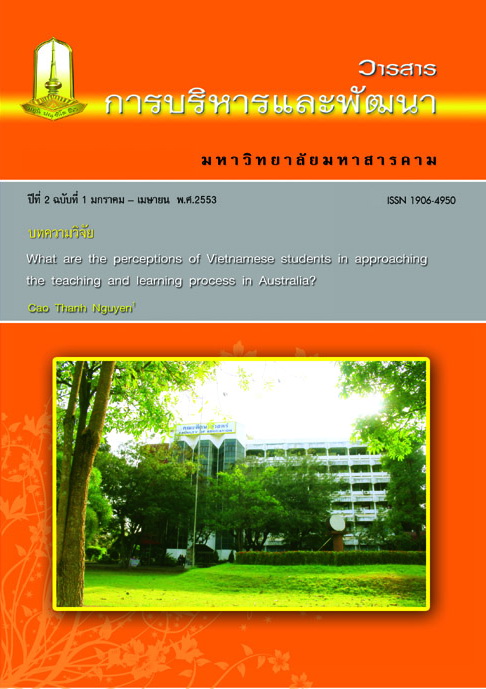การเปรียบเทียบผลสัมฤทธ์ิทางการเรียน เรื่อง หน้าที่ประชาชนไทย การคิด อย่างมวีจิารณญาณและความฉลาดทางอารมณ์ของนักเรยีนชั้นมธัยมศกึษา ปทีี่2ระหว่างการจดัการเรียนรตู้ามแนวทฤษฎีพหปุัญญากบัการจัดการเรยีน ร้แูบบJigsaw
Main Article Content
Abstract
การวิจัยคร้ังนี้มีความมุ่งหมาย เพื่อ (1) พัฒนาแผนการจัดการเรียนรู้ตามแนวทฤษฎี พหุปัญญา และเเผนการจัดการเรียนรู้แบบ Jigsaw เรื่องหน้าท่ีประชาชนไทย กลุ่มสาระการ เรียนรู้สังคมศึกษา ศาสนาและวัฒนธรรมช้ันมัธยมศึกษาปีท่ี 2 ท่ีมีประสิทธิภาพตามเกณฑ์ 80/80(2)ศึกษาดชันปีระสทิธผิลของแผนการจัดการเรยีนรูท้้งัสองรปูแบบ(3)เปรยีบเทียบผล สมัฤทธทิ์างการเรยีนเรอื่งหนา้ทปี่ระชาชนไทยการคดิอยา่งมีวจิารณญาณและความฉลาดทาง อารมณ์ระหว่างการจดัการเรยีนรู้ตามแนวทฤษฎีพหปุัญญาและการจัดการเรยีนรแู้บบJigsaw กลมุ่ตวัอยา่งท่ีใช้ในการวจิยัครงั้นี้ไดแ้ก่นกัเรียนชั้นมัธยมศกึษาปที่ี2โรงเรียนสกลนครพัฒน ศกึษาอาําเภอเมอืงสาํานักงานเขตพ้นืทีก่ารศึกษาสกลนครเขต1ภาคเรียนท่ี1ปีการศึกษา2551
The purposes of this research were : (1) to develop the lesson plans using multiple intelligences theory approach and cooperative learning with technique Jigsaw approach, entitled Duties of Thai People in the social studies, religion, and cultures learning strand of Mathayomsuksa 2 level with a required efficiency of 80/80, (2) to find out effectiveness indices of those two types of learning activities, (3) to compare learning achievement,
critical thinking, and emotional quotient of the students who learned by using the two approaches. The sample used in this study consisted of 82 Mathayomsuksa 2 students attending Sakonnakhonpattanasuksa School, Muang District, Sakonnakhon Province in the first semester of the academic year 2008 who were selected by the cluster random sampling technique. They were assigned to one experimental group with 40 students learned using the multiple intelligences approach and the another experimental group with 42 students learned using the cooperative learning with technique Jigsaw approach. The instruments used in the study were : plans for organization of learning activities using the multiple intelligences theory approach and the cooperative learning with technique Jigsaw approach, 8 plans each, for a total of 16 hours of teaching ; a 40 – item achievement test ; a 25 – item test of critical thinking ; and 25 – item rating – scale questionnaire on emotional quotient. The statisticsused for analyses of the collected data were mean, percentage, and standard deviation ; and Hotelling T2 were employed for testing the hypothesis.
The results of the study were as follows:
1. The plans for organization of learning activities using the multiple intelligences theory approach and the cooperative learning with technique Jigsaw approach entitled Duties of Thai People had efficiencies of 83.08/79.56, and of 80.24/78.21 respectively.
2. The effectiveness indices of learning by using the multiple intelligences theory approach and the cooperative learning with technique Jigsaw approach were 0.6379 and 0.6111 respectively.
3. The students who learned using the multiple intelligences theory approach and those who learned using the cooperative learning with technique Jigsaw approach did not show differences in learning achievement, critical thinking, and emotional quotients.

